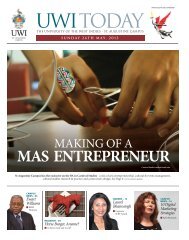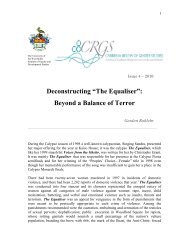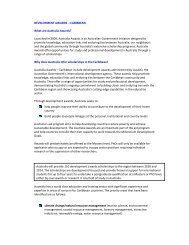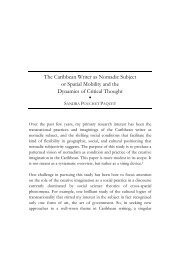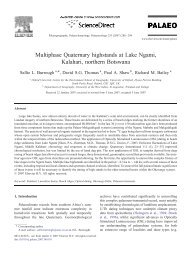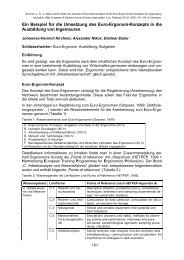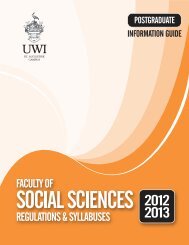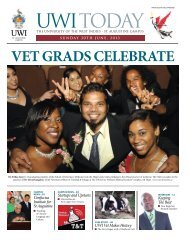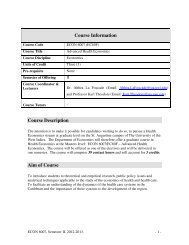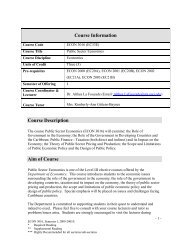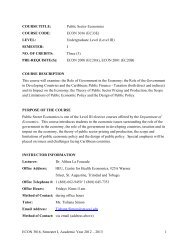Faculty of Humanities and Education (Postgraduate) - The University ...
Faculty of Humanities and Education (Postgraduate) - The University ...
Faculty of Humanities and Education (Postgraduate) - The University ...
You also want an ePaper? Increase the reach of your titles
YUMPU automatically turns print PDFs into web optimized ePapers that Google loves.
68<br />
POSTGRADUATE REGULATIONS & SYLLABUSES 2012 - 2013<br />
THE FACULTY OF HUMANITIES & EDUCATION<br />
SEMESTER: I AND II<br />
YEAR: I<br />
COURSE CODE: EDSS 5281<br />
COURSE TITLE: DESIGNING INSTRUCTION FOR THE<br />
ADOLESCENT LEARNERS – THE TEACHING OF SOCIAL<br />
SCIENCES<br />
NUMBER OF CREDITS: 6<br />
PREREQUISITES: NONE<br />
COURSE DESCRITION: This course explores the knowledge,<br />
skills, attitudes <strong>and</strong> sensitivities required for the teaching<br />
<strong>of</strong> subject matter content that comprises the disciplines<br />
collectively referred to as Social Sciences namely: Geography,<br />
History, Social Studies, Caribbean Studies, Sociology, Business<br />
Studies <strong>and</strong> Economics.<br />
Purpose <strong>of</strong> the Course/Rationale<br />
This course is intended to prepare novice teachers for teaching<br />
in a wide variety <strong>of</strong> school contexts which requires students to<br />
develop <strong>and</strong> exercise their creative <strong>and</strong> innovative ability as<br />
subject specialists. Students are equipped by way <strong>of</strong> suitable<br />
learning experiences facilitated by the lecturers <strong>and</strong> tutors to<br />
craft lessons which are interesting, meaningful <strong>and</strong> enjoyable.<br />
Course Content<br />
<strong>The</strong>re are 5 areas <strong>of</strong> focus as follows:<br />
• Orientation to curriculum<br />
This introduces prospective teachers to three core areas <strong>of</strong><br />
focus that will inform their underst<strong>and</strong>ing <strong>of</strong> their future<br />
work. It takes a macro view <strong>of</strong> the teaching act <strong>and</strong> situates<br />
it within the broad context <strong>of</strong> the wider curriculum.<br />
• Principles <strong>of</strong> Instructional design<br />
<strong>The</strong> focus here is on introductory, core concepts necessary<br />
for students to design lessons <strong>and</strong> units, such as learning<br />
outcomes, instructional objectives, instructional stimulus,<br />
taxonomies, <strong>and</strong> learning activities.<br />
• Integrating Technology in Teaching <strong>and</strong> Learning<br />
This will provide students with the analytical skills to<br />
deconstruct media products <strong>and</strong> explore ways in which<br />
technologies can be used in teaching <strong>and</strong> learning. It will<br />
sensitize educators to the theoretical <strong>and</strong> practical issues<br />
involved in the integration <strong>of</strong> computers, audio-visual<br />
equipment <strong>and</strong> other technologies used for instruction<br />
<strong>and</strong> provide training in the design <strong>and</strong> production <strong>of</strong><br />
educational materials.<br />
• Managing Diverse Classroom Environments<br />
<strong>The</strong> focus is on preparing students to manage the wide<br />
diversity <strong>of</strong> adolescent learners, learner behaviours, <strong>and</strong><br />
physical settings they are likely to encounter across a<br />
range <strong>of</strong> school types. Topics to be taught include planning<br />
differentiated instruction, using sociometric data, <strong>and</strong><br />
selecting classroom management strategies.<br />
• Teaching disciplinary content<br />
<strong>The</strong> focus will be on discipline-specific issues <strong>and</strong> how they<br />
may be conceptualised <strong>and</strong> approached pedagogically.<br />
Detailed listing <strong>of</strong> topics<br />
Orientation to curriculum<br />
• <strong>The</strong> teacher <strong>and</strong> the teaching act<br />
• Underst<strong>and</strong>ing the curriculum, <strong>and</strong><br />
• Curriculum interface.<br />
Principles <strong>of</strong> instructional design<br />
• Conceptualizing <strong>and</strong> planning units <strong>of</strong> instruction<br />
• Analyzing adolescent students’ instructional needs<br />
• Defining broad unit purposes<br />
• Defining constituent lessons for a unit<br />
• Sequencing lessons in a unit<br />
• Using instructional taxonomies<br />
• Setting instructional objectives<br />
• Planning for affective outcomes<br />
• Assessing learning<br />
• Infusing visual <strong>and</strong> performing arts in the curriculum.<br />
• Planning lessons<br />
• Defining an instructional purpose for a lesson<br />
• Matching instructional purposes to instructional<br />
objectives<br />
• Selecting stimulus materials<br />
• Sequencing instructional events within lessons<br />
• Creating coherence within lessons<br />
• 2Choosing assessment strategies.<br />
• Selecting appropriate pedagogical strategies<br />
• Direct instruction, lectures, group work, individual<br />
work, experiential learning<br />
• Choosing pedagogy for differentiated classes<br />
• Selectingstrategiesthatcaterformultipleintelligences<br />
<strong>and</strong> learning styles (e.g. role playing, drama, hot<br />
seating, debating)<br />
• Questioning <strong>and</strong> listening skills, motivational skills,<br />
interpersonal skills.<br />
Integrating technology in teaching & learning<br />
• Principles <strong>of</strong> technology integration<br />
• Policy, pedagogy <strong>and</strong> practice<br />
• Creating wikis, blogs, podcasts, websites<br />
• Creating webpages <strong>and</strong> other virtual spaces to facilitate<br />
differentiated teaching <strong>and</strong> learning<br />
• Underst<strong>and</strong>ing legal <strong>and</strong> ethical issues: copyright,<br />
plagiarism, access <strong>and</strong> other legal issues.<br />
Managing diverse classroom environments<br />
• Core principles <strong>of</strong> differentiated instruction: differentiating<br />
instruction for variations in student readiness <strong>and</strong><br />
interests<br />
• Differentiating instruction for variations in students’<br />
preferred ways <strong>of</strong> learning<br />
• Issues in classroom management<br />
• Learner behaviours, student subcultures, gendered<br />
behaviours.



